小学英语精讲精析 Fruit (2)
- 格式:docx
- 大小:57.49 KB
- 文档页数:8
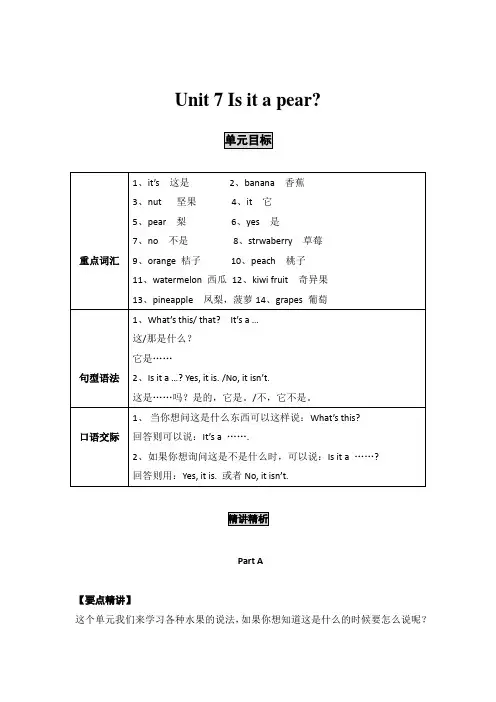
Unit 7 Is it a pear?Part A【要点精讲】这个单元我们来学习各种水果的说法,如果你想知道这是什么的时候要怎么说呢?下面我们就来了解一下英语中询问“是什么”的说法。
1、 What’s this /that?如果你想问“这是什么东西”或者“那是什么东西”时就可以用上这个句子。
回答则可以用:It’s a ……那是……。
Thisadj.这, 这个, 今, 本 pron.这, 这个 thatadj.那, 那个pron.那, 那个 2、Is it a ……?如果你想询问“这是……吗?”可以说:Is it a ……? 回答则可说: Yes, it is.或者No, it isn’t.【针对训练】一、辨一辨,标一标。
(快来为划线部分的发音作一下判断,相同的标、不同的标。
)1.2.3.4.babyballbooklookpenhenpearhear二、连一连,词汇练习。
(请帮小狗把单词和他们的汉语意思用直线连接起来)1.pencil2. pen3. baby4. bagA:书B:钢笔C:是的D:球E:铅笔F:它是G:婴儿H:书包5. book6. ball7. it’s8. yes三、补一补,根据图片提示完成句子。
1. —What’s this?—It’s .2. —What’s that? —It’s .3. —What’s that? —It’s .4. —What’s that? —It’s .5、—What’s this? —It’s .四、读一读,判一判。
(根据图片提示,判断句子的正误。
正确在句子前面的括号里划 ,错误划 )()1. —Is this a peach?—Yes,it is.()2. --Is this a strawberry.--Yes,it is.()3. —Is it a lemon.—No,it isn’t.()4. —Is it a pear?—Yes,it is.()5.--Is this a orange?--No,it isn’t.五、读一读,选一选。
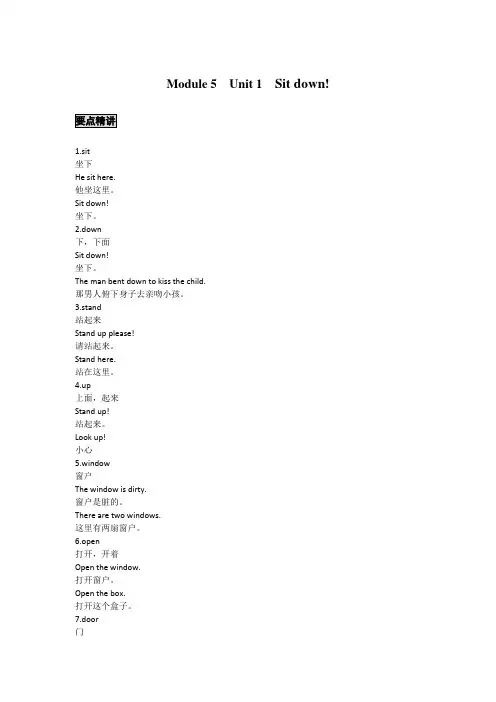
Module 5 Unit 1 Sit down!1.sit坐下He sit here.他坐这里。
Sit down!坐下。
2.down下,下面Sit down!坐下。
The man bent down to kiss the child.那男人俯下身子去亲吻小孩。
3.stand站起来Stand up please!请站起来。
Stand here.站在这里。
4.up上面,起来Stand up!站起来。
Look up!小心5.window窗户The window is dirty.窗户是脏的。
There are two windows.这里有两扇窗户。
6.open打开,开着Open the window.打开窗户。
Open the box.打开这个盒子。
7.door门He came out through the door.他从门口走出来。
8.sit down!坐下Ask them to sit down.让他们坐下。
We sit down to have a dinner.我们坐下来吃晚饭。
9.stand upShe stands up when they came in.当他们进来时, 她站了起来。
Please stand up when we call your name. 我们叫到你的名字时请起立。
10.open the ….打开…Open the box you can find a cat.打开盒子你会看见一只猫。
1.Can I ____the window?A. openB. look atC. see【答案】A【解析】打开窗户用open the window1. Sit ______, please.A. upB downC.it2.____the window.A. downB. upC. open答案:1. 【答案】B【解析】坐下是sit down2. 【答案】C【解析】打开窗户是open the…。
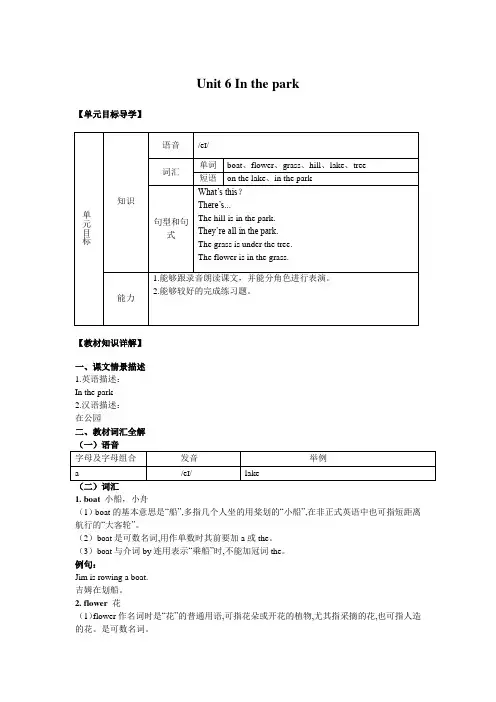
Unit 6 In the park【单元目标导学】【教材知识详解】一、课文情景描述1.英语描述:In the park2.汉语描述:在公园二、教材词汇全解(二)词汇1. boat 小船,小舟(1)boat的基本意思是“船”,多指几个人坐的用桨划的“小船”,在非正式英语中也可指短距离航行的“大客轮”。
(2)boat是可数名词,用作单数时其前要加a或the。
(3)boat与介词by连用表示“乘船”时,不能加冠词the。
例句:Jim is rowing a boat.吉姆在划船。
2. flower花(1)flower作名词时是“花”的普通用语,可指花朵或开花的植物,尤其指采摘的花,也可指人造的花。
是可数名词。
(2)flower也可表示“开花”的抽象概念,这时是不可数名词,不与不定冠词连用。
(3)flower常引申为“精华,青春”,用作单数名词,常与定冠词the和介词of连用。
例句:This flower is for you.这朵花是给你的。
3. grass 草;草场;牧草(1)grass的基本意思是“草”,指各种草的总称,通常长有绿色的叶子,可以被牛、羊等动物食用的草,也可指铺设草坪用的草,还可指一片长满草的区域,即“草地,草坪,牧场”。
grass还可用于指“禾本科植物”,此时多用来指不同种类的“草”。
有时, grass还可指向警察告密的人(自己往往是罪犯),即“告密者”。
引申可指“大麻”“基层群众”。
(2)grass作“草”“草地,牧场”解时多用作不可数名词,而作“禾本科植物”解时多用作可数名词。
例句:Don't walk on the grass.不要践踏草地。
4. hill小山;丘陵;土堆;斜坡(1)hill是可数名词,意思是“小山”,用作专有名词时如表示一座山峰,不加冠词; 如表示群山,须加定冠词。
(2)hill还可指道路上的“斜坡”。
例句:The park is on a hill.那个公园在一座小山上。
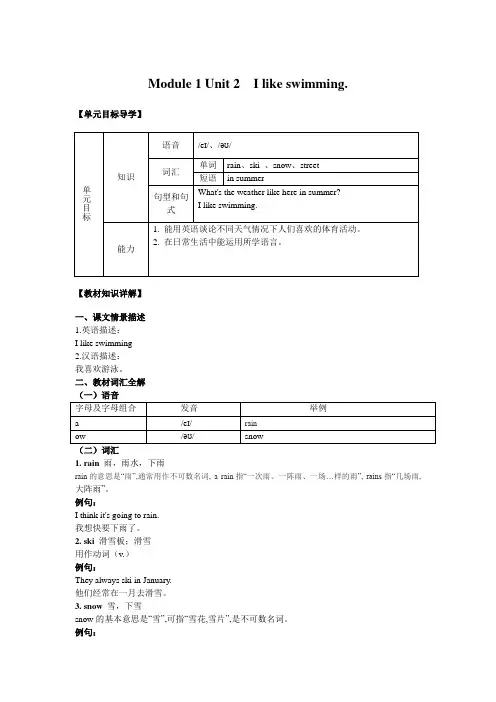
Module 1 Unit 2 I like swimming.【单元目标导学】【教材知识详解】一、课文情景描述1.英语描述:I like swimming2.汉语描述:我喜欢游泳。
二、教材词汇全解1. rain雨,雨水,下雨rain的意思是“雨”,通常用作不可数名词, a rain指“一次雨、一阵雨、一场…样的雨”, rains指“几场雨,大阵雨”。
例句:I think it's going to rain.我想快要下雨了。
2. ski 滑雪板;滑雪用作动词(v.)例句:They always ski in January.他们经常在一月去滑雪。
3. snow 雪,下雪snow的基本意思是“雪”,可指“雪花,雪片”,是不可数名词。
例句:It is snowing heavily.天正在下大雪。
4. street街,街道用作名词例句:He lives on the street.他住在这条街上。
四、课文句型讲解1. What do you like doing in summer? 夏天你喜欢做什么呢?like doing sth. 表示某人的爱好或经常性的动作,具有抽象的概念。
例句:I like swimming.我喜欢游泳。
2. I like skiing. 我喜欢滑冰。
like doing sth 是长期性的爱好。
例句:Do you like reading?你爱好读书吗?【相关话题拓展】like doing sth. 和 like to do sth. 区别like to do sth 是偶尔一次的爱好,而like doing sth 是长期性的爱好。
like+doing这里面的进行时表示喜欢经常做一件事情,这件事情也就是这个人的爱好,例如"Do you like reading?"意思是你爱好读书吗?like+to do加不定式表示想做什么事情,意思类似于want,例如"Do you like to go with me?"表示现在愿不愿意去做某事。
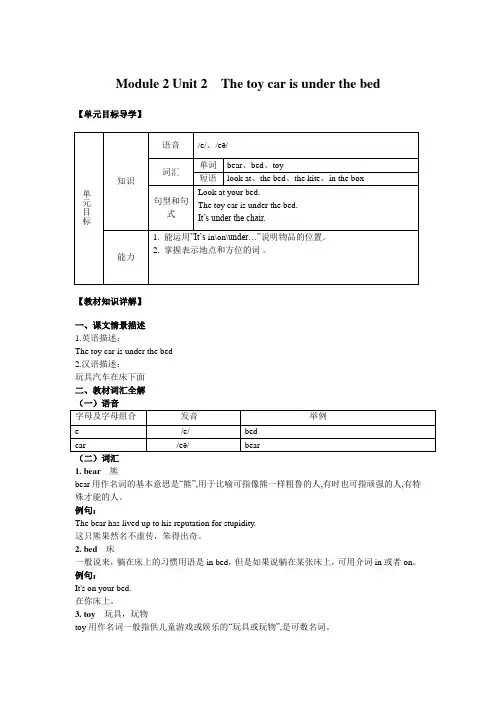
Module 2 Unit 2 The toy car is under the bed【单元目标导学】【教材知识详解】一、课文情景描述1.英语描述:The toy car is under the bed2.汉语描述:玩具汽车在床下面二、教材词汇全解(一)语音(二)词汇1. bear熊bear用作名词的基本意思是“熊”,用于比喻可指像熊一样粗鲁的人,有时也可指顽强的人,有特殊才能的人。
例句:The bear has lived up to his reputation for stupidity.这只熊果然名不虚传,笨得出奇。
2. bed 床一般说来,躺在床上的习惯用语是in bed,但是如果说躺在某张床上,可用介词in或者on。
例句:It's on your bed.在你床上。
3. toy 玩具,玩物toy用作名词一般指供儿童游戏或娱乐的“玩具或玩物”,是可数名词。
例句:The boy got a lot of toys for Christmas.这个男孩儿在圣诞节得到了许多玩具。
4.where 哪里where用作副词的基本意思是“什么地方,哪里”,可用作疑问副词,引导特殊疑问句。
例句:Where do you live?你住在哪儿?三、课文内容全译四、课文句型讲解1. The kite is under the bed ,too. 风筝也在床下面。
under 主要表示垂直在下的正下方。
例句:Look in the cupboard under the sink.到洗碗池下面的柜子里找一找。
2. Where’s the cat? 猫在哪儿呢?where用作疑问副词,在(往、从)哪里,在什么地方。
例句:Where are you?你在哪儿?【相关话题拓展】口语中的I don’t know有哪些意思1. 表示:我不知道,我说不准。
如:A:When will he be back? 他什么时候回来?B:I don’t know.我不知道。
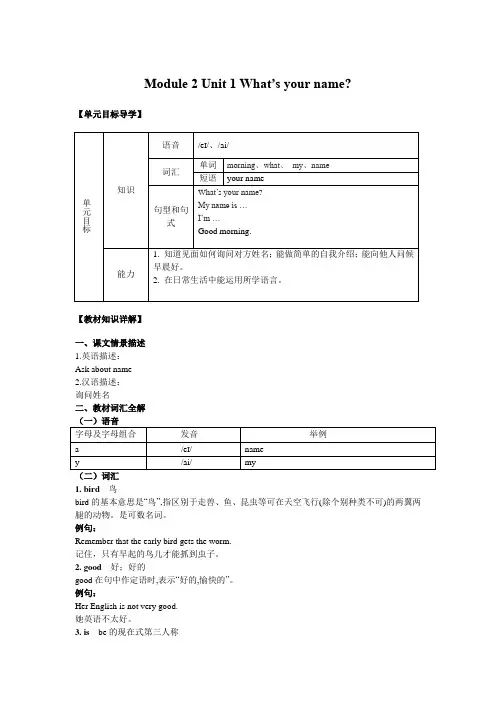
Module 2 Unit 1 What’s your name?【单元目标导学】【教材知识详解】一、课文情景描述1.英语描述:Ask about name2.汉语描述:询问姓名二、教材词汇全解(一)语音1. bird鸟bird的基本意思是“鸟”,指区别于走兽、鱼、昆虫等可在天空飞行(除个别种类不可)的两翼两腿的动物。
是可数名词。
例句:Remember that the early bird gets the worm.记住,只有早起的鸟儿才能抓到虫子。
2. good好;好的good在句中作定语时,表示“好的,愉快的”。
例句:Her English is not very good.她英语不太好。
3. is be的现在式第三人称用作动词(v.)例句:My father is a doctor.我父亲是位医生。
4. morning早晨,上午morning的基本意思是“破晓,黎明,早晨,上午”,通常指从太阳升起到正午的这段时间。
例句:What did you do in the morning?上午你做什么了?5. my 我的用作形容词(adj.)例句:You may use my bike.你可以用我的自行车。
四、课文句型讲解1. Good morning,I’m Ms Smart. 早上好,我是萨米特女士。
Good morning表示早安的意思。
例句:Good morning.早上好。
2. What’s your name?你叫什么名字?what's是what is的缩写。
用于询问别人的姓名,答句是My name is...例句:What’s your name?你叫什么名字?【相关话题拓展】人称代词人称代词有主格和宾格两种形式,第三人称的人称代词还有性别的变化。
主格主要用来做句子的主语,在正式文体中也可用作表语;宾格主要用作宾语,在口语中也常用来做句子的表语。
两个或两个以上的人称代词并列使用时,对于单数人称代词,按“二三一”的顺序排列;对于复数人称代词,按“一二三”的顺序排列。
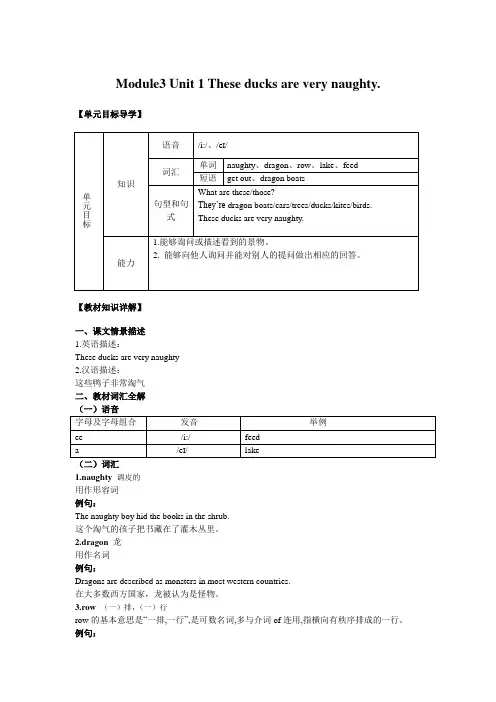
Module3 Unit 1 These ducks are very naughty.【单元目标导学】【教材知识详解】一、课文情景描述1.英语描述:These ducks are very naughty2.汉语描述:这些鸭子非常淘气二、教材词汇全解1.naughty调皮的用作形容词例句:The naughty boy hid the books in the shrub.这个淘气的孩子把书藏在了灌木丛里。
2.dragon龙用作名词例句:Dragons are described as monsters in most western countries.在大多数西方国家,龙被认为是怪物。
3.row (一)排,(一)行row的基本意思是“一排,一行”,是可数名词,多与介词of连用,指横向有秩序排成的一行。
例句:What's the boy doing between two girls in the second row?第二排坐在两个女孩中间的那个男孩在做什么?ke湖lake的意思是“湖”,一般指被地围着的大面积的流动水域或积水,船舶可在上面航行,是可数名词。
例句:They pour dirty water into rivers or lakes.他们把污水倒入河流或湖泊。
5.feed 喂(养);饲(养)feed的基本意思是“喂食”“吃”,适用于人、动物或植物。
例句:How often do you feed your cat a day?你一天喂几次猫?三、课文内容全译1. What are those?那些是什么?those是that的复数形式,是远指代词,指时间或空间上较远的人及事物。
例句:Those are his children.那些是他的孩子。
2. Let’s feed the ducks. 让我们喂那些鸭子吧。
let’s中的’s(=us)只能指说话者和听话者双方(表示建议或劝诱),不能指说话者一方(即不能用来表示命令或请求)。
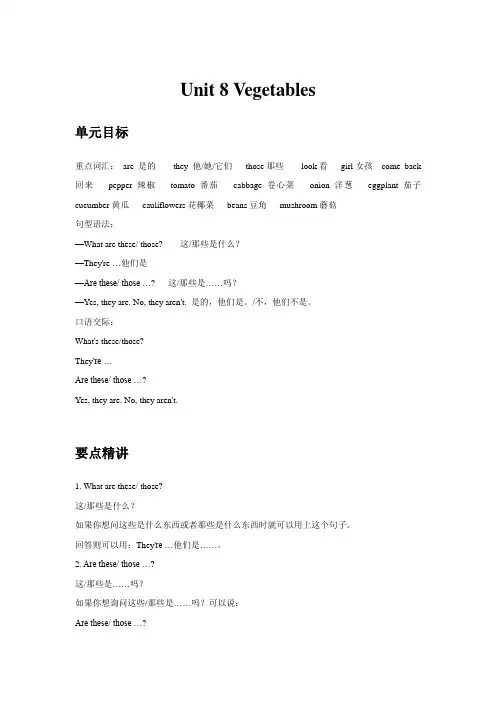
Unit 8 Vegetables单元目标重点词汇:are 是的they 他/她/它们those那些look看girl女孩come back 回来pepper辣椒tomato番茄cabbage卷心菜onion洋葱eggplant茄子cucumber黄瓜cauliflowers花椰菜beans豆角mushroom蘑菇句型语法:—What are these/ those? 这/那些是什么?—They're …他们是—Are these/ those …? 这/那些是……吗?—Yes, they are. No, they aren't. 是的,他们是。
/不,他们不是。
口语交际:What's these/those?They're …Are these/ those …?Yes, they are. No, they aren't.要点精讲1. What are these/ those?这/那些是什么?如果你想问这些是什么东西或者那些是什么东西时就可以用上这个句子。
回答则可以用:They're …他们是……。
2. Are these/ those …?这/那些是……吗?如果你想询问这些/那些是……吗?可以说:Are these/ those …?回答则可说:Yes, they are. No, they aren't. 是的,他们是。
/不,他们不是。
3. these/thosethese 这些those 那些this,that,these,those的用法区别:近指代词和远指代词this(包括其复数形式these),是近指代词。
指时间或空间上较近的人及事物。
that(包括其复数形式those),是远指代词。
指时间或空间上较远的人及事物。
This is Mr Smith and that is Mr Black. 这位是史密斯先生,那位是布莱克先生。
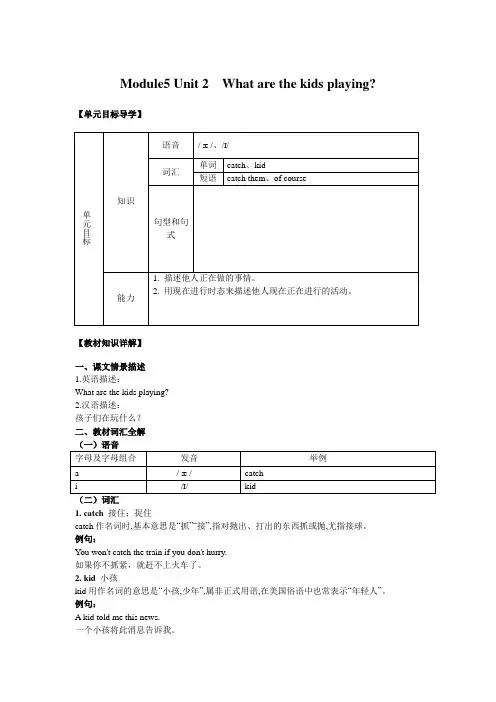
Module5 Unit 2 What are the kids playing? 【单元目标导学】【教材知识详解】一、课文情景描述1.英语描述:What are the kids playing?2.汉语描述:孩子们在玩什么?二、教材词汇全解1. catch接住;捉住catch作名词时,基本意思是“抓”“接”,指对抛出、打出的东西抓或抛,尤指接球。
例句:You won't catch the train if you don't hurry.如果你不抓紧,就赶不上火车了。
2. kid 小孩kid用作名词的意思是“小孩,少年”,属非正式用语,在美国俗语中也常表示“年轻人”。
例句:A kid told me this news.一个小孩将此消息告诉我。
三、课文内容全译四、课文句型讲解1. Can I play with them? 我能跟他们一起玩吗?Can 表示能力:能,能够,会例句:Can you drive a car?你能开车吗?2. Of course,you can.当然,你能。
Of course表示:当然;自然的意思。
例句:Of course I‘ll help you.我当然会帮你。
【相关话题拓展】“三餐饭”冠词使用规律1. 不用冠词的场合在通常情况下,表示一日三餐的 breakfast, lunch, supper前不用冠词。
如:Breakfast is served until 9 am. 早餐一直供应到上午9点。
Can you manage lunch on Tuesday? 你星期二能来吃午饭吗?Have you finished supper already? It’s only 5 o’clock!你已经吃过晚饭了? 现在才5点钟啊! 2. 用定冠词的场合虽然在通常情况下,“三餐饭”前不用冠词,但是若要特指某一顿早餐、中餐或晚餐,则可在其前加定冠词。
如:The supper is well cooked. 晚饭做得很好。
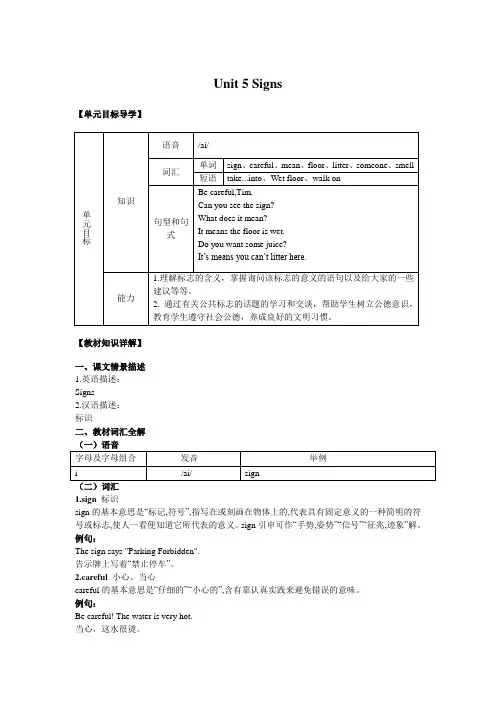
Unit 5 Signs【单元目标导学】【教材知识详解】一、课文情景描述1.英语描述:Signs2.汉语描述:标识二、教材词汇全解(二)词汇1.sign 标识sign的基本意思是“标记,符号”,指写在或刻画在物体上的,代表具有固定意义的一种简明的符号或标志,使人一看便知道它所代表的意义。
sign引申可作“手势,姿势”“信号”“征兆,迹象”解。
例句:The sign says "Parking Forbidden".告示牌上写着“禁止停车”。
2.careful 小心、当心careful的基本意思是“仔细的”“小心的”,含有靠认真实践来避免错误的意味。
例句:Be careful! The water is very hot.当心,这水很烫。
3.mean 意思是......mean的基本意思是“表示…的意思”,指某一动作或某件事物(如字母、信号等)具有某种意思,这一事物与其现在所表达意思是相同的。
mean也可指“本意是,原意为”,指某一件事物最初的意思,这个意思与其现在所表示的意思可能不同。
mean还可指“有某种重要性”。
例句:What do you mean?你是什么意思?4.floor地面floor作“地面,地板”解时,多指房间的地面,可以是木板的,也可能是水泥、石头的,甚至可以是泥土的。
例句:Don't spit on the floor.不要随地吐痰。
5.litter乱扔垃圾litter是可数集合名词,当其作主语时,谓语动词可用单数形式,也可用复数形式。
例句:There were piles of litter in the streets.街道上垃圾成堆。
6.someone 某人用作代词(pron.)例句:Someone wants to see you, sir.先生,有人想见您。
7.smell闻到smell用作及物动词时,表示“闻到,嗅到”,指闻某人或物以分辨其气味,也指“闻出”某人或某物的气味。
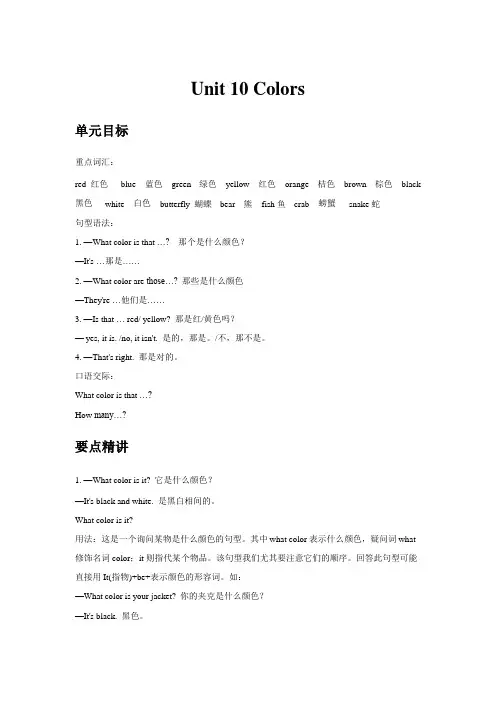
Unit 2 How much?Mocky: What's this, Ken?Ken : It's a toy train, Mocky.How much is the train, please? Stallholder: It's 20 yuan.Ann: How much is the kite, please? Stallholder: It's 8 yuan.Ann: How much is the robot. Stallholder: It's 11 yuan.Ann: How much are they all together? Stallholder: They are 19 yuan.Ken : Here's the money.Ann: Thank you. Here's your change. Ken : Thanks.Ann: Look, Mocky!Mocky: How much are these?Ken,Ann ,and Stallholder: Thief! Thief! Stop thief!Well done ,Mocky! Well done !Mocky: Ken,这是什么?Ken : Mocky,这是个玩具火车。
请问这个火车多少钱呢? Stallholder: 这个20块!Ann:那请问这个风筝多少钱呢?Stallholder: 8块。
Ann: 请问这个机器人多少钱?Stallholder: 11块。
Ann: 他们一起卖多少钱啊?Stallholder:他们一共19块。
Ken :给你钱。
Ann: 谢谢,这是找你的零钱。
Ken :谢谢!Ann: 看,Mocky!Mocky: 这些多少钱?Ken,Ann ,and Stallholder: 小偷!小偷!站住,小偷!做得好,Mocky!做得很好!Lesson 11. how much用于不可数名词。
Unit7
单词
香蕉水果坚果一(只,个)
苹果橙子,橘子桃梨
草莓甜的柠檬酸的
菠萝西瓜婴儿小船
书本熊钢笔梨铅笔
知识点
a/an的使用:
通常,以元音字母(、、、、)为开头的单词前用。
以辅音字母为开头的单词前用。
be动词(am/is/are)的使用:
我用,你用,连着他、她、它。
单数、不可数用,复数名词全用。
它是一个香蕉。
(含有be动词的句子变否定,直接在be动词后加not。
)
它不是一个香蕉。
(含有be动词的句子变一般疑问句,直接把be动词提前。
)它是一个香蕉吗??
是的,它是。
,。
不,它不是。
,。
它是什么??
词组
早上好我爱水果 touch and guess
加油,快点 pencil sharpener
一个给我,一个给你,。
Module 1 Unit 2 There are tall trees now.【单元目标导学】【教材知识详解】一、课文情景描述1.英语描述:There are tall trees now2.汉语描述:这里现在有高大的树二、教材词汇全解(一)语音1.then 那么、就then的意思是“当时,那时”“接着,于是,然后”“还有,而且”“那么,因此”,作“那时”解时可指过去,也可指将来。
例句:What shall I do then?那我该怎么办?2.playground 操场用作名词例句:They are playing football in the playground.他们正在操场上踢足球。
三、课文内容全译1. There were lots of little trees before. 这儿之前有许多小树。
there be句型的过去时态是。
There was/were…,只要把is/are改为对应的过去式was/were 就可以了。
例句:There was a small playground before.这儿以前有一个小操场。
2. How about your school? 你们学校怎么样?How about用于向对方提出建议或请求。
例句:How about going out for a walk?出去散散步好吗?【相关话题拓展】What about和How about的用法1. 向对方提出建议或请求。
例如:How about going out for a walk? 出去散散步好吗?What about another cake? 再吃块蛋糕好吗?2. 征询对方的看法或意见。
例如:What about the playing the violin? (你认为)她的小提琴拉的怎么样?What about the TV play? 那个电视剧怎么样?3. 询问天气或身体等情况。
Unit 7 Fruit单元目标重点词汇:it's这是it它yes是no不是banana 香蕉nut 坚果pear 梨strwaberry 草莓orange 桔子peach 桃子grapes 葡萄句型语法:What's this/ that? It's a …这/那是什么?它是……Is it a …? Yes, it is. /No, it isn't.这是……吗?是的,它是。
/不,它不是。
口语交际:What's this?It's a ….Is it a …?Yes, it is. 或者No, it isn't.要点精讲1. What's this/that?如果你想问这是什么东西或者那是什么东西时就可以用上这个句子。
回答则可以用:It's a …那是……。
thisadj. 这, 这个, 今, 本pron. 这, 这个thatadj. 那, 那个pron. 那, 那个2. Is it a ……?如果你想询问这是……吗?可以说:Is it a …?回答则可说:Yes, it is. 或者No, it isn't.3. fruitn. 水果, 果实, 果类, 成果vi. 结果实banana 香蕉nut 坚果pear 梨orange 桔子peach 桃子watermelon 西瓜grapes 葡萄strwaberry 草莓4. look(1)用作不及物动词, 意为看, 望, 瞧。
单独使用时, 后不跟介词。
如:I looked but saw nothing. 我看了, 但什么也没看见。
Look! Here comes the bus. 瞧!汽车来了。
Look before you leap. 三思而后行。
和at连用。
如:The teacher is looking seriously at us. 老师正严肃地看着我们。
Look at these pictures. How beautiful they are!看这些画, 它们是多么漂亮啊!和其它某些介词或副词连用:look after 照看, 照料。
如:He is old enough to look after himself. 他年龄足够大, 能照看自己。
look for 寻找。
如:I looked for you just now, but I didn't find you. 刚才我到处找你, 但没有找到。
look around 四下环顾; 到处寻找。
如:He looked around but he saw nobody. 他四下环顾, 但什么人也没看到。
look back on回想, 回顾。
如:They often look back on the days they spent together. 他们常回顾他们在一起度过的日子。
look into朝……里面看。
如:He looked into the box, but he saw nothing. 他朝箱子里面看了看, 但没看到什么。
look out当心。
如:Look out! Don't hit the tree. 当心!不要撞了树。
look over仔细检查;翻阅。
如:The doctor is looking him over. 医生正在给他做仔细检查。
look up抬头看;查;找出。
如:He looked up and smiled at me. 他抬起头, 对我笑了笑。
If there are words you don't understand, look them up in the dictionary. 如果你有不认识的单词可以查词典。
(2)用作连系动词,意为看起来。
后跟形容词。
如:You look well/fine/healthy. 你看起来很健康。
The teacher looks happy. 老师看上去很高兴。
She looks pale. 她面色苍白。
后跟过去分词。
如:You look tired; you'd better have a rest. 你看上去很累, 你最好休息一下。
后跟名词。
如:He looks a nice, honest man. 他看上去是个诚实的好人。
后跟介词短语等。
如:He looks in good health. 他看来十分健康。
5. take care 小心,当心,留神Take care/ Be careful! The pan's very hot.当心!锅很烫。
Take care/Be careful not to misuse the word.注意不要用错这个词。
②Take care not to break the jar.千万当心不要打破这个罐。
Take care there's no mistake.当心不要弄错。
典型例题1. —Is this pen yours?—No, it's not____. It's Elsa's.A. IB. meC. myD. mine答案:D解析:本题考察物主代词。
选名词性物主代词mine相当于my pen. 本题是06年中考第一题。
2. I can see an apple ________ the apple tree and a bird ________ the banana tree.A.on, in B.in, in C.on, on D.in, on答案: A解析:on表示本来就在数上的东西,如水果叶子等;in表示外来物在树上,指原来并不长在树上的东西。
所以选A。
针对训练一、语音判断。
1. A. pen B. hen C. end2. A. bag B. ball C. cat3. A. lemon B. one C. wrong4. A. peach B. tea C. pear5. A. nut B. hug C. put二、填单词。
三、根据图片和句意填空。
1. —Is it a green apple?—_________.2. —What is this?—_________.3. Is it a watermelon?.Yes, _________.4. —What is this?—_________.5. _________, this is a pear.答案:一、1. 相同 2. 不同 3. 不同 4. 不同 5. 不同二、1. babies 2. peaches 3. It's 4. bananas 5. what's三、1. No, it isn't. 2. It's a pen. 3. Yes, it is. 4. It's a banana. 5. Be careful单元测试一、单项选择。
()1.—_________ this?—It's a lemon.A. What'sB. What doC. What()2.—_________ a dog?—Yes, it is.A. Does itB. Is itC. Do it()3. —Is it a pear?—_________.A. Yes, it is.B. No, it is.C. Yse, it is't.()4. It is a _________.A. waterB. lemonC. watermelon()5. _________A. Be careful.B. Take care.C. Carefully二、根据问句找答语。
()1. What's this? A. No, it isn't.()2. What color is it? B. It is too danger.()3. Is it a dress? C. It is red.()4. Look. D. It's a nut.()5. Be careful! E. That is a big bird.三、连词成句。
1. a is teddy it bear?2. It's my son gift a from.3. is an old it women.4. is what this?5. so you clever are.四、排序。
1. It's a nut.2. I see.3. No, it isn't.4. Is it a pear?5. What's this?顺序为:_______________________.五、阅读理解。
Sam is a little boy, and he is only eight years old. One day he goes to the cinema. It is the first time for him to do that. He buys a ticket and then goes in. But after two or three minutes he comes out, buys a second ticket and goes in again. After a few minutes he comes out again and buys a third ticket. Two or three minutes later he asks for another ticket. Then the girl in the ticket office asks him, Why do you buy so many tickets? How many friends do you meet? Sam answers, No, I nave no friend here. But a big boy always stops me at the door and tears my tickets in piece.1. Sam wants to buy ________ when the girl asks him.A. the second ticketB. the third ticketC:the fourth ticket D. the fifth ticket2. The big boy stops Sam at the door because ________.A. it is the big boy's jobB. the big boy doesn't like SamC. the big boy doesn't know SamD. Sam doesn't buy tickets3. The big boy is ________ of the cinema at all.A. a booksellerB. a policemanC. a shop keeperD. a worker4. From the story we know ________.A. the little boy has a lot of moneyB. the little boy knows nothing about the cinemaC. Sam doesn't like the filmD. the girl wants to get more money答案:一、1. A 2. B 3. A 4. C 5. A二、1. D 2. C 3. A 4. E 5. B三、1. It is a teddy bear.2. It's a gift from my son.3. It is an old woman.4. What is this?5. You are so clever.四、43512五、1. C 2. A 3. D 4. B。